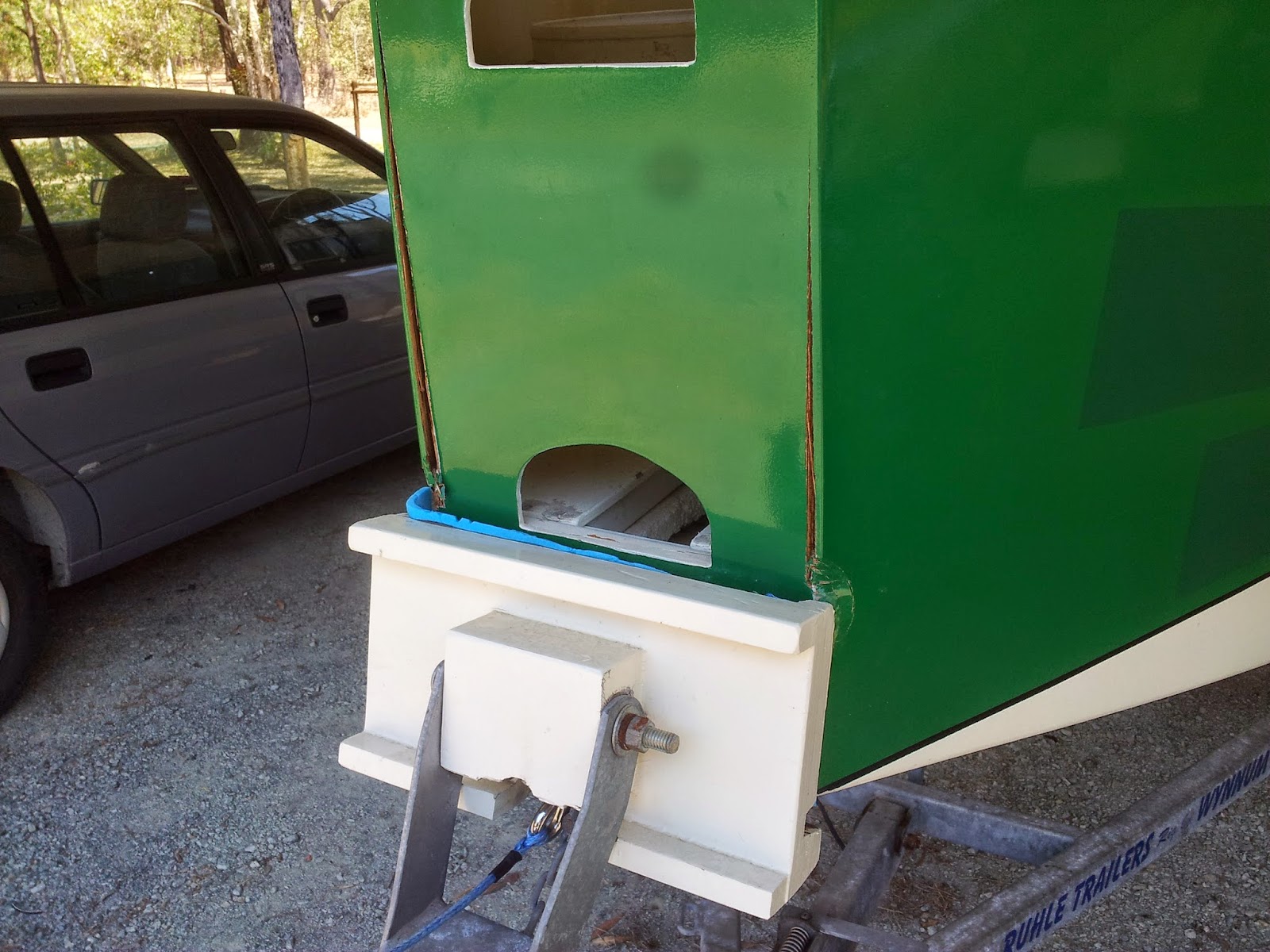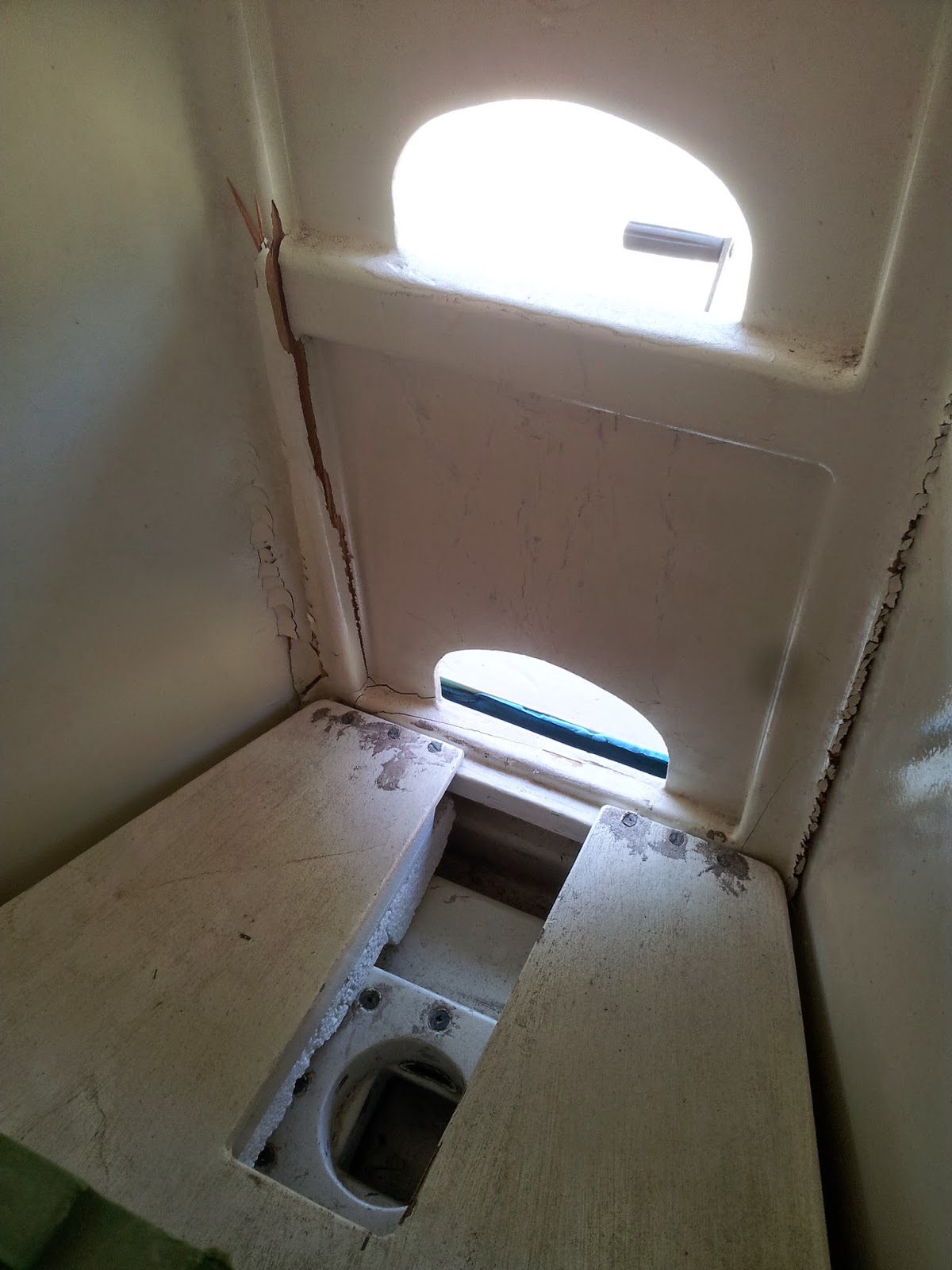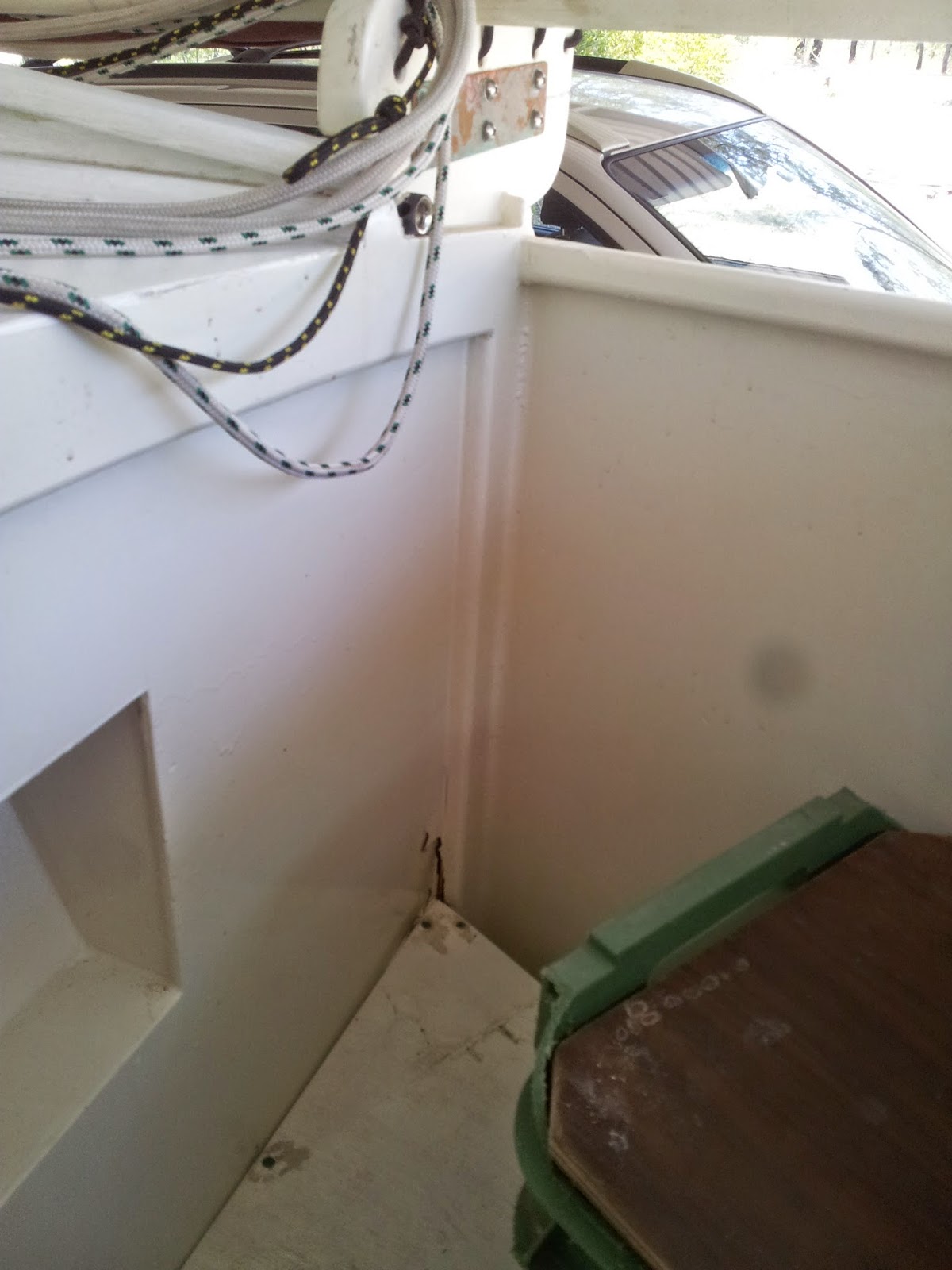I've told the story of how I came to design
Phoenix III several times previously, but for those who haven't heard it before, the basic details are:-
- after 45 years of dinghy sailing, I settled on 15ft x 4ft 6ins (to the inside of the planking) as being the best compromise between light-weight and compact size on the one hand, and carrying capacity, speed and capability on the other. All of this viewed in the context of a single-hander, or a two person crew;
- good rowing geometry and performance;
- self-rescuing;
- trailerable;
- a selection of simple, traditional, interchangeable rigs, all using the same mast step and mast partner.
![]() |
| The very first Phoenix III , beautifully built by Paul Hernes |
The original builder, Paul Hernes, from Caloundra, Australia, has used his boat extensively in the more than ten years since initial launching. Paul has done what I encourage everybody to do - he has continually experimented with the various rigs, making changes to the running rigging, and learning the characteristics of his boat. I am indebted to Paul for his feed-back and photos.
Another person to whom I owe a debt of gratitude is Tom Pamperin, from Wisconsin in the United States. Tom has notched up months of cruising time in a Phoenix III built by his brother, Lance. You can read about some of Tom's cruising adventures, and view his superb photos by following these links:-
http://forum.woodenboat.com/showthread.php?186576-A-Phoenix-III-in-Georgian-Bay&p=4422412#post4422412http://forum.woodenboat.com/showthread.php?134797-A-Phoenix-III-in-the-North-ChannelMore recently, Tom and a friend competed in the 2016 "Texas 200", and Tom has kindly written a nice article on the trip. It is a great story and you can see it here: -
A Phoenix III in the Texas 200
by Tom Pamperin
www.tompamperin.com
The Texas 200 is hard to describe. It’s not a race. And it’s not really a group cruise, either. I think of it as more of a multi-day endurance event for small boats: 40 to 50-mile sailing days, strong winds, tricky navigation, intense sun, remote campsites, extreme shallow water, and no shade. There’s some big water, too. Although the route roughly parallels the Intracoastal Waterway, and is sheltered from the open water of the Gulf of Mexico by a series of low barrier islands, it can get rough out on the larger bays. Conditions can be tough enough to be intimidating—or at least exciting—at times. This year, 57 boats started and 29 finished, with just 18 boats making it to every camp along the way. My brother was kind enough to loan me his Phoenix III for the trip so that my friend Pete and I could give it a shot.
Magnolia Beach, Texas—finish line of the Texas 200. (Peter Martens photo)
The sign sets the tone perfectly—this ain’t no marina cruise. Logistics for the Texas 200 can be daunting. Most sailors arrive a day early to drop off their boats at the start (Port Isabel, Texas, a tourist town near the Mexican border), and then drive their car and trailer 5 hours north to the finish line at Magnolia Beach and catch a shuttle bus back to Port Isabel that afternoon—another 5 hours of driving.
Day One: Crossing the Laguna Madre. (Jennifer Votaw Crow photo)
Our trip started out with a long day of surfing along on a broad reach to a run at 5-6 knots for 40 miles non-stop. These are typical Texas 200 conditions, with winds at 20 knots or more in the morning and getting stronger all day, all on the starboard tack. The Phoenix III handled it beautifully, with fingertip control of the tiller and no tendency to broach.
To keep things interesting, the day ended with a 5-6 mile beat up a narrow channel dredged through the barrier island forming the eastern edge of the Laguna Madre, with the campsite located right on the edge of the Gulf of Mexico. More than a few boats quickly abandoned the attempt to beat up the channel; for us in the Phoenix III, it was a simple series of tacks through steep chop—a bit wet, but we never missed a tack and stayed perfectly in control. Pete shot a bit of video at the camp that night to give his family some idea of what the Texas 200 is all about:
On the beach at the Port Mansfield jetties. (Peter Martens video)
Day Two: More of the Laguna Madre. (Peter Martens video)
More of the same for day two—big wind, broad reach to a run. Continue for 8 hours. Pete shot the brief video on his IPhone while we were surfing along. He’s done some Hobie sailing back in Wisconsin, but I don’t think he had ever seen this kind of sustained surfing before.
Day Three: Northward to Bird Island. (Matt Schiemer photo)
The photo above shows the campsite for the evening of day three near Bird Island, just outside of Corpus Christi. Another 40 miles on a broad reach to a run to get here—with a side trip to the barrier islands. At one point we were completely surrounded by porpoises, who started launching themselves into full-on aerial leaps all around us. Pete and I were laughing out loud. Later on we “parked” the boat to wait for a sailor who had fallen behind by simply letting the sheet run free, letting the sail weathervane freely while we drifted slowly and peacefully to leeward, broadside to the wind—a nice feature of the Phoenix III’s balance lug rig.
Day Four: Pete at the helm, entering Corpus Christi Bay.
The low sheeting loads on the lug rig make expensive blocks and hardware unnecessary—we simply ran the sheet around a horn cleat on the leeward quarter, forward to the oarlock, and back to the helmsman’s hand. Another advantage of such a simple arrangement is that the sheet can be kept much shorter, leaving less line to tangle around the crew’s feet. We also sometimes ran the sheet through a ring on a simple rope traveler over the tiller, another cheap and easy method that’s a bit handier for gybing.
The winds finally relented a bit—down to 20 knots, maybe—so we spent the day under full sail. Today brought the big water and long fetches of Corpus Christie Bay, so we hugged the windward shore, sliding through narrow channels along and around the barrier islands, sailing in water so shallow that, board up, the keel was dragging through the mud. “Deep water” on the Texas coast means water that might get your knees wet if you stepped overboard.
Later in the day we could have cut back into the deep buoyed route of the ICW, but there was a better option for boats like ours: Corpus Christie Bayou. We simply ignored the marked channel and sailed up to a crumbling ramp at the edge of a bridge, lowered the mast to row through, and re-hoisted the sail. From here the route to camp was an exercise in extreme shoal-water sailing, trying to find a twisting channel which had shuffled itself outside of its own markers, forcing us to guess where deeper water might be found.
Again, not a problem in the Phoenix III. Since the channel wasn’t reliable, we simply cut across the flats, sailing along in water so deep that the keel (board up) was once again buried in the mud. We only had to get out and pull the boat along for about thirty yards, and we were through to deeper water and the oyster-shell beach of the Quarantine Shores campsite.
Camp at Quarantine Shores—plenty of home-built boats, and not much else. (Peter Martens photo)
Day Five: Sailing through the night. (Bill Fisher photo)
Light winds, for Texas at least. We spent the day on a broad reach under full sail, still doing between four and five knots. In the afternoon the winds picked up, shifting eastward far enough to put us close-hauled—the first time since day one that we hadn’t been on a broad reach or a run.
The day ended at Hidden Pass, where we sailed through a cut almost narrow enough to jump from island to the next—with a running start. Maybe. I couldn’t get Pete to try it, so we’ll never know for sure. We did find an alligator skeleton on the beach, so perhaps his reluctance to risk a swim was well-founded.
At camp that night, everyone with radios and smart phones was talking about tomorrow’s weather forecast: very hot, with light winds. “It might not be the dumbest idea to just keep going through the night,” I told Pete. True, there’d be some tricky navigation getting through one of three marked cuts into the next bay—but the moon was nearly full. And we had a good breeze now. It would be a pleasure to sail while it was cool for once; we had been decked out in long sleeves and long pants for days, trying to protect ourselves from the fierce sun.
And so we hung out with the fleet at camp until sunset—right around the time that mosquitoes would have forced a retreat into tents anyway—and then set out across Espiritu Santo Bay, the last big water of the trip. Perfect sailing! A nice 15-knot breeze, cool air, and the fierce red eye of the sun hidden safely below the horizon. I was surprised no other boats came along, but I guess they wanted to see how we did before they tried it for themselves. Maybe next year it’ll become a popular strategy.
The winds picked up as we went, and then suddenly fish began popping out of the sea all around us. Quite remarkable—they would hurl themselves straight up, four or five feet into the air. One of them even jumped overthe foredeck.
Then one of them jumped into the boat. And another. Using a boat cushion, I scooped them down toward Pete, who had his hands full already with the tiller and sheet. “Fish in the boat!” I shouted as another one threw itself aboard. “Fish in the boat!” He threw them overboard one by one and mocked me for my timidity. I kept wielding my cushion and pushing them his way.
The rain of fish kept on for half an hour. They were mullets, sleek silvery fish half the length of my forearm, and were no doubt being pursued by bigger, hungrier fish. Porpoises, perhaps. I sympathized with them, but still, I wasn’t letting them stay aboard.
By the time we reached the far shore of the bay on our moonlit sail, we weren’t sure of our exact location. I don’t carry a GPS (I cling to a stubborn curmudgeonly belief that such devices remove many of the rewards of sailing, and make us less skillful and less aware), so we had steered a compass course designed to take us far enough south of our goal that we would know to turn north when we hit the shore.
It worked, kind of. Bumping along northward through the shallows, using the centerboard as a depth sounder, we followed the far shore of the bay until a vague cluster of lights showed up ahead. Somewhere near there would be our cut. We passed a marker buoy from the ICW, but weren’t able to locate the channel itself in the darkness. And then suddenly we had land on both sides of the boat, a development that was difficult to reconcile with the chart, using a tiny red headlamp as the waves tossed the boat this way and that. But eventually, despite the first faint stirrings of seasickness, I was able to get a pretty good guess at where we were.
Which proved wrong in the next moment as we discovered a buoyed channel cutting directly across our path: it was the last of the three channels we had been looking for, and we had found our way successfully through the darkness.
The rest of the night was a quiet sail northward as the winds gradually dropped away, until around 4 a.m. we coasted up onto the beach under oars. Magnolia Beach. If the Texas 200 had been a race (it isn’t), we would have just won. Then again, given how much we had enjoyed our nighttime sail, we had won. Everyone else would be bobbing and baking in hot sun and no wind for hours. Pete and I pulled the boat ashore, set up our tents, and enjoyed a few hours of sleep in the cool air of the morning.
Conclusions: A very good boat. (Peter Martens photo)
The author and his brother’s boat at the finish line: the beach at Magnolia Beach.
Judging by the results—57 entries, 29 finishers, and only 18 boats (including us) making it to every campsite— this year’s Texas 200 was a tough event for a lot of people. For Pete and me aboard the Phoenix III, it was a pleasure cruise. I’ve put a lot of miles on my brother’s boat, and the more I sail it, the more I like it. Anything I’d be brave enough to try in a small boat, I’d be happy trying in a Phoenix III.
I’ll end by explaining a few of the features of the design that I have really come to appreciate. These may not all be the things that come easily to mind when you’re new to this kind of sailing—they are instead appreciations that have evolved gradually, after many hundreds of miles of cruising under sail and oar, rolling the boat up onto beaches, anchoring off and sleeping aboard, the whole spectrum of cruising life. In short, these are the things I didn’t know enough to want from a boat until I had put in some sea miles.
1. The simple balance lug rig is easy to reef, easy to strike for rowing, docile and well-mannered in use (gybing is particularly simple and stress-free), and allows you to “park” the boat by simply letting the sheet fly so the boat drifts quietly broadside to the waves. It’s also easy to raise the sail anywhere on the starboard tack (if you rig with yard to port as I do)—no need to hold the bow precisely into the wind as on a Marconi rig (and thus no need for the complications of a mizzen). And the mast is simple to drop if you need to slip under a low bridge.
2. Capsize recovery. My brother and I tested this on a windy day (20 knots+) and found it EXTREMELY difficult to capsize this boat, even on purpose. But when we did (after leaning 400+ pounds over the leeward gunwale for 20 seconds), it was easy to right and re-board—so easy I’m confident I can do it for real if the situation ever comes up. And the centerboard design puts the top of the case well above the water level, meaning the boat can be bailed dry without taking in more water through the case.
3. Sleeping platform. The optional set-up for sleeping aboard works well for two sailors, and is luxurious (by backpacker standards) for a solo sailor. Simply carry an extra plank under each side bench and the entire width of the boat becomes a comfortable sleeping space. A simple tarp on a line from mast to rudder head makes a good boom tent to keep you dry. I’ve switched almost entirely to sleeping aboard because of how simple and comfortable it is.
4. Good rowing performance. The Phoenix III is no racing shell, but I was able to outrun a Hobie with a pedal-powered Mirage drive for an hour while rowing at a pace slightly faster than my all-day endurance pace. This boat makes rowing a pleasure rather than an ordeal.
5. Good windward ability. Gentlemen don’t sail to windward—except sometimes you have to. The Phoenix III keeps up good speed and points well, and the fine entry and wide gunwales make it a fairly dry ride.
6. Glued lapstrake plywood construction. I’d rather be sailing than sanding and fairing, and lapstrake is probably the quickest and most pleasant route to get there if you’re building a new boat. It also makes for a stiff, strong, lightweight hull.
But the best feature of the Phoenix III—a quality I have not often seen to this degree in other designs—is less quantifiable: it’s just right. The layout and proportions feel natural; it all works, in a very practical and user-friendly way. This is a boat that seems to have been designed by someone who actually goes cruising, and has thought a lot about what works and what doesn’t. The thwart divides the boat neatly into stowage (forward) and living areas (aft). The anchor bucket fits easily along the forward bulkhead alongside the mast. Large duffel bags stow neatly alongside the centerboard case, held in place under the thwart—it’s much easier to carry a couple of bags ashore than it is to dig through small hatches. The bags also increase flotation if the boat is swamped or capsized.
In fact, the ergonomics of this boat work so well that even two large (6’ 2”) adults can fit comfortably aboard for a long cruise. And sailing solo, the helmsman can slide fore and aft along the side benches, moving all the way forward to the thwart for windward work, and sliding back to the sternsheets for running, keeping his weight right where it needs to be.
And because the centerboard is designed so that it does not intrude on the helmsman’s space (after experiencing this, I’ll never accept a cruising boat without it), it is VERY easy to switch sides when tacking and gybing. This is something you’ll do hundreds of times (if not thousands) aboard a cruising dinghy, and it is a simple and enjoyable move every time on the Phoenix III.
All in all, I haven’t seen a boat I like better for sail-and-oar cruising. I doubt I ever will.


.jpg)
.jpg)
.jpg)

.jpg)























